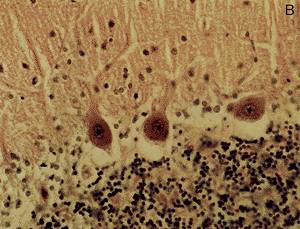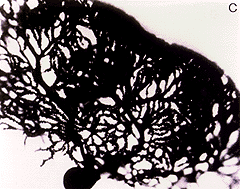The Black Reaction – La reazione nera
The Purkinje cell of the cerebellum is used as an example to illustrate the revelatory power of the Golgi stain, and why it was and still is important. The extension and orientation of dendrites of the Purkinje cells provided a key for the understanding of how the cerebellar cortex is built up and works (the same could be stated for all other structures of the brain, in which how neuronal processes are arranged is the prerequisite for their functioning). The anatomist Evangelista Purkinje described the large cells in the cerebellum (A) that bear his name. With the methods available at Purkinje’s time, he could only observe the cell bodies. No branches can be seen even in the routine histological stains (thionin, cresyl violet) still used nowadays (B). C demonstrates that the Golgi stain fully visualizes the entire extent of ramifications of this particular neuronal cell type and its spatial orientation. This is crucial for the functioning of the cerebellar cortex, since the axons of granule cells (called parallel fibers) coursing tangentially establish several hundred thousands of contacts with the dendrites of each Purkinje cell (D).

 |
| B illustrates the cerebellar cortex in a routine histological stain (Nissl stain) still commonly used nowadays: in the upper part of the photo the molecular layer (with very few cells, indicated by their nuclei – the dark dots – ) can be seen, then there is the Purkinje cell layer (with three large cell bodies visible) and then the granule cell layer (with densely packed small cells). With this stain, dendrites of Purkinje cells extending into the molecular layer can hardly be identified. |

 |
| D illustrates the general organization of cerebellar cortex and shows the crucial role played by the ramifications of the Purkinje cells and their spatial orientation. |
The ‘impact’ of the knowledge of the cell architecture and the orientation of its dendrites on the clarification of the structure and function of the cerebellar cortex is explained in this drawing of the cerebellar cortex (D). Without knowing how and where the individual cell bodies extend their processes it would have been very hard to have clues on the organization of the cerebellar cortex. The same applies to all the other neural structures.
Nobel Prizes and laureates
Six prizes were awarded for achievements that have conferred the greatest benefit to humankind. The 12 laureates' work and discoveries range from proteins' structures and machine learning to fighting for a world free of nuclear weapons.
See them all presented here.
